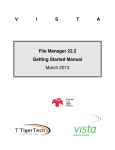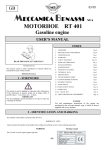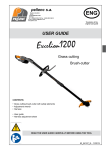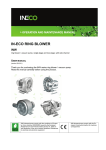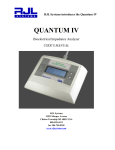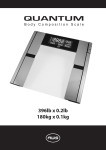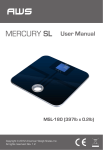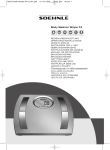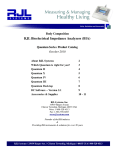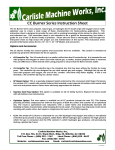Download printing reports using the rf link
Transcript
Quantum-III User’s Manual RJL Systems 33939 Harper Avenue Clinton Township, Michigan 48035, U.S.A. (800) 528-4513 (586) 790-0200 (586) 790-0205 (FAX) -1- Manual Revision Date: August 29, 2007 -2- TABLE OF CONTENTS Intended Usage ............................................................................................................5 Indications for use Intended Population Contraindications Warnings Precautions System Contents ........................................................................................... 6 Quantum-III Hardware ................................................................................. 7 Charging the Q3 ............................................................................................ 8 What Happens When Q3 is Turned ON? ..................................................... 9 Introducing the Main Menu .......................................................................... 10 Setting System Preferences .......................................................................... 11 Setting the Time and Date ............................................................................ 12 Testing the Subject Cables............................................................................ 13-14 Subject Preparation ....................................................................................... 15 Electrode Placement ..................................................................................... 16 Performing a BIA Test .................................................................................. 17-18 The Record Menu — Getting Results .......................................................... 19 BIA Questions ............................................................................................... 20-21 How do I measure frame size? How is target weight calculated? What do the different Activity Levels mean? Definitions—What do the Results Mean? .......................................................... 22-23 Printing Reports Using the RF Link............................................................. 24-27 Sample Report……………………………………………………………..28 -3- -4- INTENDED USAGE Indications for use The Quantum-III measures or calculates the following values: Resistance, Reactance, Impedance, Phase Angle, Body Fat* (FAT), Fat-Free Mass/Lean Body Mass* (FFM/LBM), Total Body Water* (TBW), Intra-Cellular Water* (ICW), ExtraCellular Water* (ECW), Basal Metabolic Rate* (BMR), Daily Energy Expenditure* (DEE), Body Mass Index (BMI) * Estimated Intended population / usage The Quantum-III is intended to be used on normally healthy individuals aged 12-90, who have not had an arm or leg amputated. It is not intended to diagnose or treat a disease or medical condition. Contraindications No known contraindications exist. Warnings Bioelectrical Impedance Analysis (BIA) devices, like the Quantum-III, operate by introducing an alternating current (AC) signal into a body, and then detecting how that signal is affected by the body. This device should not be used on subjects with any implantable electronic devices such as pacemakers or implantable cardioverter defibrillators (ICDs). Women who are tested with this device should not be pregnant or suspected of being pregnant. Besides increased inaccuracy of readings in this condition, the effects of the measurement on the fetus are unknown. Precautions Failure to follow the subject preparation and testing procedures (detailed on pages 15-16) may result in incorrect readings. The person performing the BIA tests must also be able to demonstrate proficiency in electrode placement. See page 15 for conducting a proficiency test. -5- SYSTEM CONTENTS Pouch containing subject cables and test resistor Pouch containing Q3 charger Adhesive Electrodes ( Behind Pouch ) Pouch containing USB and serial cables Quantum-III Quantum-III RF Link ( Under Quantum-III ) Printer Charger ( Under Quantum-III ) Mini Thermal Printer USB RF-Link ( Under Printer) User manuals for the Quantum-III, Mini Thermal Printer, and PC Body Composition Software are not shown in the picture above. -6- INTRODUCING QUANTUM-III HARDWARE FRONT of Quantum-III Power Controls Previous Field ( UP Arrow ) Next Field ( DOWN Arrow ) Battery Charging Status Indicator Multi-Purpose Serial Port BACK PANEL of Quantum-III Charger / Subject Cable Port -7- Connects to: • Mini Thermal Printer • PC • RF-Link CHARGING the Q3 To charge the Q3, first connect the power cord to the charger, and plug it into the wall. Second, plug the charging cable into the round Subject Cable/Charger connector in the center of the back panel. You will notice an indentation on the charger cable connector. This indentation must line up with the arrow on the back panel to insert the connector. The indentation on the connector must line up with the arrow. Also on the back panel is an array of four lights which indicate the charging status of the Q3. These lights will only turn on if the Q3 is plugged in. The lights have the following meanings: LOCATED ON BACK PANEL • Batteries OK While the charger is plugged in and the batteries are charging, this light should blink once per second. Once the batteries are fully charged or the charger is disconnected, this light will stop blinking and turn off. • Rapid Charge This light turns on when the batteries are charging quickly. How long the system stays in this mode depends on how low the batteries were when the Q3 was plugged in. • Top-off Charge When the charging system detects that the batteries are close to being fully charged, it slows the charging rate to protect the batteries. • Done Charging Once the batteries are fully charged, this light will turn on. At this point, the system enters a maintenance mode, and the batteries are monitored to ensure that they remain fully charged. If the batteries are low, it can take up to five (5) hours for the batteries to become fully charged,. It is recommended the Q3 be allowed to charge overnight. The Q3 uses a “smart” charging system, which protects the batteries from being overcharged. Therefore, it is perfectly safe to leave the Q3 plugged in when not in use. Please note: While the Q3 is plugged into the charger, it cannot be used to perform BIA tests or to do system maintenance. If the Q3 is turned on while charging, it will either display a message saying “batteries charging” or “batteries fully charged”. -8- WHAT HAPPENS WHEN THE Q3 IS TURNED ON? If the Q3 is turned on and is plugged into the charger, it will display a message about the battery status (see “Charging the Q3”). If the Q3 is turned on and is NOT plugged into the charger, the following sequence of events will occur: 1. Self Tests The Q3 will begin by performing a series of self-tests to ensure the internal circuitry is properly calibrated and working correctly. This takes approximately 15-20 seconds. It is imperative the charger not be plugged in while the self-tests are in progress. This will confuse the Q3 and make some future tests fail. If this happens, turn the Q3 off and then back on to clear the error. 2. Title Screen After the tests have completed successfully, the Q3 will display the title screen for approximately five seconds. In addition to the name of the analyzer, this screen will also show you the version information for the firmware (program) running on the Q3. If you ever have a problem with the Q3 and need to call tech support, the technician will ask you for this information. 3. Current Date and Time The Q3 will spend another five seconds showing you the current date and time. Please check to ensure this date and time is correct because any reports printed or BIA records saved will have this timestamp. To change the timestamp, you can either press “0” to go to the Change Time form, or you can wait and come back to this page from the main menu later. Performing self-tests The title screen Current Date and Time (See Introducing the Main Menu and Changing the Time and Date.) 4. Main Info Page If the subject cables are plugged into the Q3 and connected to a test subject, this page will show the current measured resistance and reactance; along with the calculated impedance and phase angle. Otherwise, this page will only contain the message that the subject cables are disconnected. For a brief description of the measurements’ meanings, see the section: “What Do the Results Mean?” Main page with subject cable connected. Main page—subject cable disconnected -9- INTRODUCING THE MAIN MENU Navigation through the program that runs on the Q3 is done by use of a couple of menus. To get to the main menu, press the MENU key. When you do, the top four lines of the menu will appear on the screen. For reference, the entire menu is shown below on the right. Use the up and down arrows to move the blinking cursor through the list of screens. When the cursor is next to the screen you want, press the ENTER key. Here is a brief introduction to the various screens listed in the main menu: • • • • • • • Main Page You were introduced to the main page in the previous section. This screen shows you either the BIA readings currently being measured (if cables are currently connected to the patient) or the message saying the cables are disconnected. Time & Date This screen is shown briefly when you turn on the Q3. It displays the current time and date which will be printed on reports or saved on BIA records. This screen provides the opportunity to update the Q3’s system clock. Subject Input This screen is used to enter patient data to calculate body composition. Once all of the necessary data has been inputted, you will have the opportunity to view body composition results and print reports. Edit Preferences The preferences screen allows you to configure the behavior of the Q3. You can set units for height and weight, time and date formatting, etc. Storage Status The Q3 is capable of temporarily storing 110 body composition test records in its memory. Records saved on the Q3 are preserved (even when it is turned off) until they are downloaded into a program on a PC. Going to this screen will show you how much space remains in the memory. Run Self Tests Selecting this menu option will re-run all of the tests that are performed every time the Q3 is turned on. About This menu option takes you to the title page that you were introduced to in , “What Happens When the Q3 is Turned On.” - 10 - The Main System Menu SETTING SYSTEM PREFERENCES In the main menu, move the cursor to the field next to “Edit Preferences”; press ENTER. Selected options are marked with an ‘X’ to the left of the field. Shown on the right, the 24-hour time formatting and Month/Day/Year date formatting are both selected. To change a setting, (for example, to set 12-hour AM/PM formatting) move the cursor to the left of the field of the desired option and press ENTER Please note: The communications speed should always be set to “9600” unless you are using custom-designed hardware with your Q3. The System Preferences Form When all options have been changed to the desired settings, press MENU to return to the main menu. • Height Units Tell the Q3 whether you will be entering people’s heights in inches or centimeters. • Weight Units Tell the Q3 whether you will be entering people’s weights in pounds or kilograms. Results that are weights (i.e. amount of fat) are also formatted according to this setting. • Time and Date Format These settings control how the date and time gets formatted when it is displayed on the screen or printed on a report using the mini thermal printer. If you are printing via a PC Link, how the date and time get formatted will depend on the settings of the PC application used to print the report. • Print Using This setting is used to format a report which is to be printed. If you will be using the mini thermal printer, select “Attached Printer”. If you will be printing via a program on your PC using either a direct cable connection or the RF Link, set the option to “PC Link”. • Communications Speed This setting allows you to select one of two different data rates. HOWEVER, unless you are connecting the Q3 to a custom piece of hardware or software which specifically requests the higher setting, you should always leave this setting on 9600. - 11 - SETTING TIME and DATE Display the current time and date by selecting “Time & Date” from the main menu. You will notice that, at the bottom of the screen, it says “Press ‘0’ to change”. Press ‘0’ to change the time and date. Displaying current time & date Use the arrow keys to move back and forth between the fields. To change an entry: (1) Use the back-space key to erase the old value; (2) Enter the new one. If you are using 12-hour AM/PM time formatting, you will see in the upper-right corner, “1 AM / 2 PM” below a field showing whether it is morning or afternoon/evening. To set the clock to AM, set this value to “1”. For PM, set it to “2”. When you are satisfied with the time settings, press MENU to return to the main menu. The settings on this form will now be written to the Q3 clock. - 12 - Change Time & Date Form TESTING SUBJECT CABLES The subject cables are delicate. Abuse can cause breaks in the wires. Frequently, this leads to incorrect resistance and reactance values and readings that rapidly change or “jump around”. Be careful not to tie them in knots or to fold them over. When storing the subject cables, they should be coiled loosely and placed in their storage pouch. The cables should be tested regularly or any time you receive readings that “don’t look right.” RJL Systems receives calls from new customers asking how regularly we recommend testing the cables. A set of subject cables should last a long time, if they are used gingerly and treated with respect. Testing them once every few months is not a bad idea. 1. Navigate to the main page of the Q3. Assuming the subject cables are disconnected, you should see the message shown to the right. [1] Cables are Disconnected Message on the Main page 2. Connect the subject cables to the Q3. On the round subject cable connector, the indentation must line up with the arrow on the back panel of he Q3 to allow proper insertion of the connector. 3. Take the test resistor out of its storage tube. Connect the clips from one of the cables to the wire on one side of the resistor. The red clip must be between the black clip and the resistor. 4. Connect the other two clips to the wire on the other side of the resistor in the same manner. It does not matter which cable gets connected to which wire—the test resistor cannot be connected “backwards”. What matters is that both clips from the same cable get connected to the same side of the resistor. [2] The indentation on the connector must line up with the arrow. [3] - [4] The subject cables properly connected to the test resistor Once the subject cables have been connected to the test resistor, you should see the screen change to show you the current resistance, reactance, impedance, and phase angle. These measurements may appear before all four clips are connected to the resistor, but it is imperative that all four clips do get connected before proceeding with the test. - 13 - TESTING SUBJECT CABLES (Continued) The resistance value should read almost exactly 500 Ohms. Readings of 499 or 501 are acceptable. Now, gently move the cables around while watching the screen of the Q3 for any large changes in the resistance value. Changes of +/-2 Ohms in resistance while you are moving the cables around are acceptable. Changes of 10 Ohms or more are not. If you see large changes in the resistance readings, then your cables are damaged and need to be replaced before you perform any BIA tests. Please call RJL Systems to order a new set. The Cables are Disconnected Message on the Main age - 14 - SUBJECT PREPARATION ELECTRODE PRECAUTIONS Before testing any patients and collecting date from BIA tests, it is highly recommended that the specialist demonstrate a proficiency in electrode placement. This proficiency is proven by the specialist conducting two consecutive tests on the same subject and receiving results which differ from each other by less than one percent (1%). Proficiency Test 1. Connect all four electrodes to the subject and attach the subject cables. Note the resistance and reactance values on the main page. 2. Disconnect the cables and remove and discard the electrodes. 3. Repeat steps (1) and (2) with a fresh set of electrodes. 4. To demonstrate a proficiency, the values from the two tests should differ by less than one percent (1%). Subject Preparation • • • • • • • • • The person being tested should not have exercised or taken a sauna within 8 hours of the study. The person being tested should refrain from alcohol intake for 12 hours prior to the study. The person being tested height and weight should be accurately measured and recorded. The person being tested should lie quietly during the entire test. The person being tested should not be wet from sweat, and any lotion on the hand and foot must be removed with an alcohol swab. The person being tested should not have a fever or be in shock. The study and testing procedure should be explained to the person being tested . The exam area should be comfortable, and free of drafts. The exam table surface must be non-conductive, and be large enough for the person being tested to lie supine, with the legs not in contact with each other, and the arm at an approximate 30° angle to the body. - 15 - ELECTRODE PLACEMENT Placing the Electrodes The BIA test is normally performed on a person’s right side. Either side of the body could be used, but it is important to consistently test on the same side of the body for all tests performed on any given individual. Begin by making sure that the subject cables are connected to the Q3, and that the analyzer is turned on. Find the ulnar head by feeling the joint of the wrist. Imagine or draw a line bisecting the ulnar head, perpendicular to the arm. Place the hand detecting electrode proximal (on the hand side) to this line, with the tab of the electrode pointing away from the body. The hand’s signal electrode should be wrapped around the middle finger, with the tab facing away from the body, which should put it inline with the detecting electrode. The medial mallealus (inside ankle-bone) should be used in the same manner as the ulnar head to place the foot’s detecting electrode. The foot’s signal electrode should be placed at the base of the big toe, inline with the detecting electrode. Connect the red clips of the subject cables to the detecting electrodes, and the black clips to the signal electrodes. Now, if you navigate to the main page on the Q3, you will be able to see the current measured resistance and reactance. - 16 - PERFORMING A BIA TEST Select “Subject Input” from the main menu. The top four lines of this page are shown on the right. Here is a brief rundown of what the input fields are asking for: • Subject ID This field is used by your computer to be able to differentiate one patient from another. • The Subject ID field is REQUIRED if: 1) You will be saving the test record on the Q3 to be later transmitted to your PC or 2) You will be using the RF link to print reports from your PC. • The Subject ID field is OPTIONAL if: 1) You do not plan to save the tests or 2) You are not going to use the RF Link to print reports. • An example of a setting where you might not want to save the reports would be if you were performing BIA tests at a health fair, where you were seeing large numbers of people whom you did not expect to see as long-term clients. The Subject Input Form • Height The patient’s height, in whichever units were selected in the “Edit Preferences” form. • Weight The patient’s weight, in whichever units were selected in the “Edit Preferences” form. • Age The patient’s age. • Gender To enter the patient’s gender, enter ‘1’ if the person is male, ‘2’ if the person is female. If the patient has undergone surgery for gender reassignment, it is important to enter the patient’s original gender at birth. Men and women are genetically programmed to distribute fat throughout the body differently, and these differences in distribution need to be compensated for by the Q3 when the resistance and reactance values are analyzed. • Frame Size The Q3 will adjust its calculation of the patient’s target weight based on their frame size. Enter ‘1’ for a small frame, ‘2’ for a medium frame, and ‘3’ for a large frame. For detail on measuring frame size, see How do I measure frame size? - 17 - PERFORMING A BIA TEST (Continued) • Target Weight You may choose to either enter your own target weight value, or you can allow the Q3 to calculate one for you. The method the Q uses is described in: “How is target weight calculated?” • Activity Level The activity level field gives the Q3 a general idea of how much activity the patient regularly sees as a result of his/her average daily routine. For descriptions that might help you choose which activity level to select, see What do the different activity levels mean? Enter 0 for “Very Light”, 1 for “Light”, 2 for “Moderate”, 3 for “Heavy” and 4 for “Exceptional”. • Resistance & Reactance You may choose to either manually enter values for resistance and reactance, or if the subject cables are currently connected to the patient, you can have the Q3 automatically fill in the currently measured values by pressing ‘0’ with the cursor on the field labeled “Press ‘0’ here to read BIA values:” • Save Record? You may choose to answer either yes or no to this question. To proceed to the Record Menu and get the test results without saving the record, press Enter with the cursor next to ‘no’. To save the record before getting the result, answer ‘yes’. • Exit to Main Menu Once you are in the Subject input form, you can not exit back to the main menu by pressing the “Menu” key. This is to prevent you from accidentally exiting from the form and losing your inputted data. To exit back to the main menu, place the cursor on this field and press Enter. To perform a BIA test and get results: 1. Fill in all fields except, optionally, the Subject ID and target weight fields 2. Answer either YES or NO to the “Save Record” question. If any field contains a value outside of an allowable range, or if there are any other problems, a message will be displayed describing the error, and you will be taken back to the subject input form and given an opportunity to correct the error. If there are no problems and you answered “Yes”, then you will be briefly shown a message telling you how many records are saved on the Q3 (including the one you just entered) before you are taken to the record menu. - 18 - If the record is saved, the storage status is shown before going to the record menu. THE RECORD MENU — GETTING RESULTS Once you have entered the subject record and answered either ‘yes’ or ‘no’ to the Save Record question, you will be brought to the record menu, which is shown to the right. • Edit Record To go back to the Subject Input form to review the data you inputted, or to make changes, select this option. • View Results Selecting this option takes you to the results screen. (shown below) You will be able to scroll up and down through the list of calculated results with the up and down arrow keys. While in the results page, pressing the menu button will bring you back to the record menu. • Print Report Selecting this option will send the report to be printed. How it gets sent depends on how printing was configured in the preferences screen. If “Attached Printer” was selected in the preferences, then the Q3 will assume that the mini thermal printer is attached to the Q3’s serial port, and will format the report layout accordingly. If “PC Link” was selected, then the Q3 will assume that the serial port on the Q3 is either connected to an RF Link with your PC, or is directly connected to your PC with a serial cable. • Enter New Record If you are done with this test, but have another to enter, select this option. • Exit to Main Menu If you are done viewing results and printing reports for this test, and have no more tests to enter select this option to return to the main menu. The Record Menu The Results Page - 19 - BIA QUESTIONS How do I measure frame size? There are two methods for measuring frame size: • The Precise Method First, measure the patient's height. Next, use a measuring tape to measure the circumference of the patient's wrist. (make sure to use the same units for both measurements. Do not mix inches and centimeters.) Divide the height by the wrist circumference. If the result is greater than 10.4, the patient has a small frame. If it is less than 9.6, the patient has a large frame. Otherwise, the patient has a medium frame. • The Easy Method A simpler, albeit less precise, method is to have the patient wrap the thumb and forefinger of one hand around the wrist of the other hand. If the thumb and forefinger overlap, the person has a small frame. If the tips of the thumb and forefinger touch, the person has a medium frame. If there is a gap, the person has a large frame. How is target weight calculated? On the subject input form, you can choose to either enter in your own value for target weight, or you can allow the Q3 to calculate one for you. The formulas that the Q3 uses to calculate target weight are called the “Hamwi Ideal Weight Equations” which are as follows: • For Males Target weight = 106 + 6 x ((height in inches) - 60) • For Females Target weight = 100 + 5 x ((height in inches) - 60) Once you have a target weight, if the patient has a small frame, adjust it for the patient’s frame size. If the patient has a large frame, add 10% to get the final value. If the patient has a small frame, subtract 10%. - 20 - BIA QUESTIONS (Continued) What do the different Activity Levels mean ? Basal Metabolic Rate (BMR) is an estimate of how many calories your body would burn in a 24 hour period if your body were completely at rest. To get an idea of how many calories your body actually requires in a day, select the activity level that best describes how you spend the majority of your day. ( > 12 hours / day ) Under each label below is a list of representative activities to help you choose the most appropriate activity level. Earlier body composition analysis software from RJL Systems used different labels for the activity levels, which are listed in parenthesis. • Very Light ( No Exercise ) Seated and standing activities, painting, driving, laboratory work, typing, sewing, ironing, cooking, playing cards, playing a musical instrument • Light ( Some Exercise ) Walking on a level surface at 2.5 to 3 miles per hour ( 4 - 4.8 kilometers per hour ), garage work, carpentry, restaurant trades, house-cleaning, child care, golf, sailing, table tennis • Moderate ( Moderate Exercise ) Walking 3.5 to 4 miles per hour ( 5.6 - 6.5 kilometers per hour ), weeding and hoeing, carrying a load, cycling, skiing, tennis, dancing • Heavy ( Athletic ) Walking with a load uphill, tree felling, heavy manual digging, basketball, climbing, football, soccer • Exceptional ( Elite Athlete ) Extremely strenuous physical activity - 21 - DEFINITIONS What do the Results Mean? • FAT Fat is the energy storage of the body. Everybody needs fat in their bodies, but it is important not to have too much. • Fat Free Mass (FFM) This value is, literally, what would be left after all fat was removed from the body. Many people also refer to FFM as Lean Body Mass (LBM). • Total Body Water (TBW) Literally, the total amount of water in the body. Since fat is essentially 0% water, TBW is entirely contained within FFM. • Intra-Cellular Water (ICW) “Intra-Cellular” literally means, “Within the cell”. This is the portion of the water in the body that is contained inside the cells. • Extra-Cellular Water (ECW) This is the portion of water in the body that is not contained within the cells. Examples of where ECW normally occurs include blood plasma, joint fluid, and bladder contents. • Target Weight If you and your patient know how much he/she should weigh, this value can be manually entered. Otherwise, it is calculated using a set of standardized formulas. • Body Mass Index (BMI) A person’s BMI is equal to their weight in kilograms divided by their height in meters, squared. BMI is commonly used as an indicator of whether someone is overweight. It is important to note, however, that somebody who is “overweight” may not necessarily be “over-fat”. A 5’10”, 300 pound couch potato and a 5’10”, 300 pound bodybuilder will have exactly the same BMI. • Basal Metabolic Rate (BMR) Basal Metabolic Rate is the number of calories that a person will use per day, by virtue of simply being alive (i.e., lying still and breathing). • Daily Energy Expenditure (DEE) People generally do not lay in bed all day, doing nothing but breathing. To estimate how many calories a person actually burns in a day, the program will adjust the BMR based on what you entered as the person’s daily activity level. - 22 - DEFINITIONS (Continued) Resistance Resistance is a measure of how difficult it is for electricity to flow through an object. • Reactance Most objects have some capacitance, which is a measure of ability to store an electrical charge. When an alternating current (periodically changes direction, like a BIA signal) flows through an object that has some capacitance to it, the current is slowed down. The more capacitance the object has, or the faster the current changes direction, the less the object will “react” to the current. nce a d e Phase Imp Angle Reactance • Resistance Diagram showing the relationship between Resistance, Reactance, Impedance and Phase Angle • Impedance RJL Systems’ analyzers measure resistance and reactance, which are the component vectors of impedance. Imagine, on a map, drawing a line going East from your house. Call this line Resistance. Now, from the end of that line, draw a shorter one going North. Call this line Reactance. Now draw a line from the end of Reactance back to your house. The length of this diagonal line is what is reported as impedance. • Phase Angle Phase angle is the angle between resistance and impedance, and is measured in degrees. - 23 - PRINTING REPORTS USING THE RF LINK Before you can use the RF Link to print reports from your Q3, you must have the RJL Systems Print Monitor installed and running on your PC. You must also have the Q3 configured to print via the Link. Installing and Launching the Print Monitor Use either of these shortcuts to launch the Print Monitor. You will know that the print monitor is running when you see the RJL icon in your computer’s System tray. In addition to letting you know that the print monitor is running, right-clicking the icon will bring up the menu for changing settings Desktop Shortcut and Start Menu entry for the Print Monitor If you have received software with your Q3, the print monitor will be installed when you install the software. Please follow the software installation instructions in the software manual. Once the software is installed, you should have shortcuts on your desktop and in the Start Menu for launching the Print Monitor. The RJL icon in the system tray shows the Q3 printing monitor is running and the printing monitor’s menu. Note: If you are running Windows XP, depending on your settings, Windows may be hiding some of the icons in your system tray. If that is the case, you will see an arrow icon in your system tray. Click this icon to be able to see the icons that Windows is hiding. By default, once the print monitor has been installed, it should automatically start every time you log in. - 24 - Clicking this icon will show you all of the icons that Windows has hidden in your system tray. PRINTING REPORTS USING THE RF LINK Attach the PC half of RF Link to PC Raise the antenna of the PC RF Link unit and connect it to your PC with the USB cable (included). Your computer should automatically detect the RF Link module and prepare it for use, although it may not appear to actually do anything. If your computer displays an error message in a bubble, unplug the RF Link module and plug it back in. Please note: If you attempt to connect the RF Link to your PC before installing the software, it will display an error message every time. The RF Link requires special device drivers, which are installed with the software. The PC RF Link unit, which attaches to your computer with a USB cable. Attach the Q3 RF Link to the Serial Port of the Q3 IMPORTANT: Make sure that the Q3 is turned off before connecting or disconnecting the RF Link unit. Failing to do so could result in serious damage to one or both devices. The Q3 portion of the RF Link plugs into the serial port on the back of the Q3. When the Q3 is turned back on, the Light at the bottom will turn on to show that it is connected properly and that it is receiving power. The upper light will flash briefly whenever it is used to send data back to the PC. This portion of the RF Link connects to your PC via a USB cable. Setting up the System Preferences on the Q3 In order to be able to communicate via the RF Link, the Q3 must be properly configured. In the preferences form, select “PC Link” for printing and “9600” for the Serial Port Speed. - 25 - Preferences form on the Q3, showing the settings for printing via the PC PRINTING REPORTS USING THE RF LINK Setting up the Print Monitor for the BIA Software Before the print monitor can be used to print reports from the Q3, it has to be configured. Two different groups of settings may need to be adjusted in the print monitor. “Print Settings” control how the print monitor interacts with the BIA software on your PC. “Serial Settings” control how the print monitor communicates with your Q3. Configuring Print Settings Right-click on the system tray icon for the print monitor and select “Change Print Settings”. The window to the right will appear. After installation, the printing program and printing command should already be set correctly. Here is a rundown of what the settings mean: The Print Settings window for the Q3 Print Monitor • • • • Printing Program—This is the program that will be used to print the report. This should be set to the location of the main program file for the body composition software on your PC. Printing Command—This command is sent to the above program, along with the data and remaining settings, to tell it to print. Please reference the manual for your PC body composition software to ensure that this setting is correct. Database—Before printing a report, the record will first be saved to this database. This field must contain the complete location to a valid database. Otherwise, the report will not print. Once you have created a database in your PC body composition software, you will want to change this value to ensure that the records from the Q3 are placed in the appropriate database. Quick Report—This is the name of the layout that will be used by the PC to print the report. If you create a new Quick Report layout in your PC software, you may change this setting to use the new layout. You will likely want to change the Database and Quick Report settings. For more detailed information and to verify what values to put in the “Printing Program” and “Printing Command”, see the manual for your PC body composition software. - 26 - PRINTING REPORTS USING THE RF LINK Configuring Serial Settings In addition to specifying the program and settings to use to process the report to be printed, serial port settings must be configured so that the Quantum-III can communicate with your PC. In general, every setting (except for Port) should be set as shown on the left. To get to this window, select “Change Serial Settings” from the Print Monitor’s menu. The Port drop-down menu will list all serial ports (also known as COM ports) identified on your computer. Many computers will skip port numbers, so identifying which port to use may initially be difficult. One rule of thumb to follow is that if using a regular serial cable to connect to the unit, you will likely want to select a port in the COM1 - COM4 range. If there is a USB cable involved, such as if you are using the RF Link to print wirelessly, the port you want will most likely be COM5 or higher. Note that the Port drop-down box is grayed-out in the picture above. This means that the port is currently open, and cannot be changed. If this occurs, close the port from the monitor’s menu before going to “Change Serial Settings”, make the desired changes, and then reopen the port. The Print Monitor MUST have a port open in order to communicate with the Quantum-III. If you try printing a report from your Q3 and nothing happens, verify that the port is open. If so, try closing the port, selecting a different port, and then opening it. When Not to use the RF-Link The RF-Link may only be used for printing the current test record with the PC body composition software. When downloading multiple records to the PC application’s database or printing via the mini thermal printer, the Q3 must be directly connected to the computer or printer with a cable. Attempts to use the RF Link to download multiple records will generate errors. - 27 - Sample Report ════════════════════════════════════════ Date:08/29/2007 ID# :2 Age: Height: Weight: Frame Size: Time: 12:04:17 Eq Set: NHANES-III 31.0 years Sex: Female 65.0 IN Resistance: 599.5 120.0 LB Reactance: 63.5 Medium Impedance: 602.9 Phase Angle: 6.0 Body Mass Index (BMI) : Target Weight : Target Fat Range % : Target weight based on Target Fat Range : A sample report from the included mini thermal printer is shown to the left, reduced to 2/3 of normal size. If the individual’s body fat percentage is within 3% of the “Target Fat Range” or below, the “Recommendations” section of the report will not print. Reports from the Quantum-III can also be printed through additional body composition software on a PC. For samples of those report layouts, see the documentation for the PC software. 20.0 125.0 19.1 - 24.1 111.3 - 118.7 ═════════════ Metabolism ═══════════════ Basal Metabolic Rate (BMR): 1329.1 Daily Activity Level: Very Light Daily Energy Expend. (DEE): 1727.9 ══════════ Body Composition ════════════ Mass % of weight Fat (FAT): 29.9 24.9 Fat Free Mass (FFM): 90.1 75.1 ══════════ Fluid Composition ═══════════ Litres % of weight % of Total Body (TBW): 30.4 55.8 TBW Intra-Cellular(ICW): 16.2 29.8 53.4 Extra-Cellular(ECW): 14.1 26.0 46.6 ═══════════ Recommendations ════════════ It is recommended that you lose 5.1 LB of body fat. The maximum rate of fat loss that is generally considered safe is 2.0 LB /week. At this rate, it should take approx. 2.56 weeks to reach your target. Based on your daily activity level, it is estimated that you require 1728 calories of food to keep your weight stable. To lose 2.0 LB per week through diet alone, you would have to reduce your food intake to 728 calories per day. If, on the other hand, you were to exercise regularly, you would not need such a restrictive diet to achieve the same rate of weight loss. If your exercise program is done consistently, (every other day) then your BMR and daily energy expenditure will improve, thereby increasing the efficiency of burning calories. Ideally, most of the weight you lose will be fat. It is normal to lose some excess water, especially during the initial phase of your diet and/or exercise program. This may cause fluctuations in your Total Body Water and Fat Free Mass. A regular exercise exercise program will increase your Fat Free Mass and decrease Body Fat throughout your weight loss program. ════════════════════════════════════════ - 28 -






























